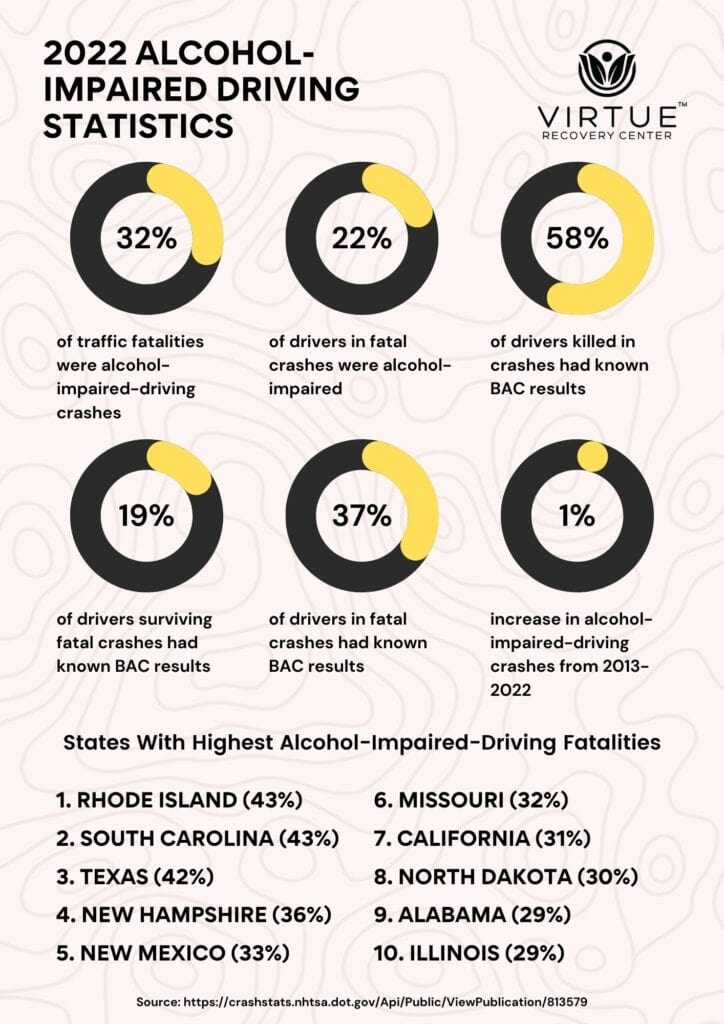Key Takeaways
- In 2022, alcohol-impaired driving caused 32% of traffic fatalities, totaling 13,524 deaths.
- States like South Carolina and Texas saw the highest percentages of impaired driving deaths.
- Legal blood alcohol concentration (BAC) limits vary, with Utah enforcing a stricter threshold of 0.05 g/dL.
- Public awareness campaigns and technology-based solutions can help reduce drunk driving incidents.
Introduction
Driving under the influence (DUI) is a significant public safety concern in the United States. Despite decades of education and enforcement efforts, alcohol-impaired driving remains a leading cause of preventable traffic deaths. The statistics from 2022 paint a sobering picture of the risks and consequences of DUI.
Understanding the financial, human, and legal costs of drunk driving is essential. This article provides a statistical overview of alcohol-impaired driving in 2022, explores state-level variations, and examines ways to combat this persistent problem.
The Scope of Alcohol-Impaired Driving in 2022
Statistics on Fatalities
Alcohol-impaired driving contributed to 32% of traffic deaths in 2022, resulting in 13,524 lives lost. States like South Carolina and Rhode Island reported the highest percentages of fatalities, with 43% of all traffic deaths linked to impaired driving. Texas closely followed with 42%.
Drunk driving is not just a statistic—it represents lives lost and families torn apart. These numbers highlight the urgent need for continued education and prevention efforts.
Drivers in Fatal Crashes (Deaths in The United States)
In 2022, 22% of drivers involved in fatal crashes were alcohol-impaired. Regional differences reveal that Utah had the lowest percentage at 14%, while Rhode Island topped the list at 31%. This disparity reflects the varying effectiveness of state-level policies and enforcement.
Blood Alcohol Concentration (BAC) and Legal Standards
BAC Testing Rates
Only 37% of drivers involved in fatal crashes underwent BAC testing in 2022, a significant drop from 51% in 2013. Testing rates varied widely by state, ranging from 8% in Mississippi to 81% in Montana. This inconsistency complicates efforts to gather accurate data on impaired driving.
Legal BAC Limits
The national BAC limit is 0.08 g/dL, but Utah has set a stricter limit of 0.05 g/dL. For commercial drivers, the threshold is even lower at 0.04 g/dL. Drivers under 21 face zero-tolerance laws in most states, emphasizing the seriousness of underage drinking and driving.
Economic and Human Costs of Drunk Driving
Legal and Financial Consequences For Drunk Drivers
A DUI conviction can be financially devastating. Offenders face fines, legal fees, and increased insurance premiums, which can double or triple following a conviction. In some cases, drivers may also lose their jobs, particularly if driving is a key component of their work.
Human Impact of Drunk Driving Crashes
Beyond the financial costs, the human toll of drunk driving is immeasurable. Each statistic represents a person—a life lost, a family grieving, or a survivor living with physical or emotional trauma. Communities also suffer as resources are diverted to address the aftermath of these preventable tragedies.
Preventing Drunk Driving: What Works?
Public Awareness Campaigns About Drinking and Driving
Efforts like the “Drive Sober or Get Pulled Over” initiative have been successful in raising awareness about the dangers of drunk driving. These campaigns remind drivers of the risks and encourage them to make responsible choices.
Technological Innovations For Monitoring Driving Behavior
New technologies, such as ignition interlock devices, prevent intoxicated individuals from starting their vehicles. Advances in vehicle-based BAC detection systems could further reduce impaired driving in the future.
Stricter Legislation For Impaired Driving
States with stronger DUI laws, such as Utah, have seen reductions in alcohol-related traffic deaths. Implementing and enforcing consistent policies nationwide could save thousands of lives each year. Furthermore, states that prioritize comprehensive education and prevention programs, alongside stricter regulations, have shown even greater success in reducing DUI incidents. By partnering with local organizations to offer extended outpatient program hours, more individuals can access vital support and resources for recovery. Collectively, these efforts could significantly enhance road safety and foster a culture of responsibility among drivers.

Conclusion Drunk Driving Deaths Statistics
Drunk driving continues to claim thousands of lives annually, leaving a trail of heartache and loss. The statistics from 2022 reveal the widespread impact of alcohol-impaired driving, highlighting the urgent need for action.
Education, technological advancements, and stricter laws are critical in reducing drunk driving incidents. Most importantly, we must prioritize prevention and support for those struggling with alcohol misuse.
If you or a loved one is struggling with addiction, reach out to Virtue Recovery Las Vegas at 866-520-2861. Help is available to guide you toward recovery and a safer future.
FAQs About Consequences of Drunk Driving Statistics 2022
What is the national BAC limit for drivers?
The national BAC limit is 0.08 g/dL. Utah enforces a stricter limit of 0.05 g/dL.
Which states had the highest rates of drunk driving fatalities in 2022?
South Carolina and Rhode Island reported the highest rates, with 43% of all traffic deaths involving alcohol-impaired drivers.
What are some consequences of a DUI conviction?
A DUI conviction can lead to fines, legal fees, higher insurance premiums, and job loss.
How can we prevent drunk driving?
Preventative measures include public awareness campaigns, ignition interlock devices, and stricter laws.
What should I do if I suspect someone is driving under the influence?
Call law enforcement immediately to report suspected impaired drivers. Doing so could save lives.
Resources
https://crashstats.nhtsa.dot.gov/Api/Public/ViewPublication/813579








